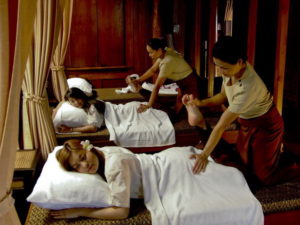When we hear the word “massage,” we typically associate it with muscles. Got a sore muscle? Get it massaged. Got knots in your muscles? Get them massaged. Are stiff muscles getting you stressed? Get them massaged.
But what about getting a massage for your joints? We don’t usually associate massages with bones and joints. After all, massage therapists typically target specific muscle groups whenever they work on a body. What we don’t realize is that the less stressed a muscle gets, the less pressure it puts on the joint. Movement and relaxation are more natural, so as a result, we also get to relax our joints.
Here are four ways that massage can help arthritis sufferers:
1. Massage should never be painful

Getting a massage when you already have arthritis might make you hesitate because of the pain involved. But the truth is, a massage should never be painful. It should be comforting and relaxing. Slight discomfort and momentary soreness may occur, but those symptoms will go away shortly after.
The key is to find the perfect pressure level for you. There are several kinds of massages available, all with varying pressure levels. If it’s not too uncomfortable for you, try to get a massage with moderate pressure. Arthritis.org recommends moderate pressure for massages because it stimulates relaxation as the blood pressure goes down.
2. Don’t be afraid to explore other massage kinds

Let’s say you finally decided to take the plunge and get a Swedish massage. Known for being a massage modality with light pressure, you don’t feel as if your muscles received enough stimulation. You go home unsatisfied and unhappy about the whole experience.
Before you swear off getting a massage, consider researching what other kinds of massages are available. There’s a whole range of modalities out there, all with their specific goals and processes. For example, trigger point massage involves deep pressure on particular parts of your body to release muscle “knots.” Meanwhile, a Thai massage incorporates stretching throughout the entire session.
3. A simple massage goes a long way

While regular visits to a massage therapist can surely help your arthritis symptoms, it can also get expensive. Insurance companies only cover a small number of massage sessions, so the rest will have to be paid out of pocket. If you’re on a tight budget, this might not be ideal for you.
The good news is that you can do simple massages to your joints at home. In fact, according to Tiffany Field, Ph.D. of University of Miami School of Medicine, regularly massaging your muscles and joints significantly reduce pain among arthritis patients. And this is regardless of whether the massage was done by a professional or by yourself.
Make sure to ask your massage therapist for some tips on simple massages that you can do by yourself. Most of the time, you don’t need anything fancy: just your hands and some pressure. If your fingers are affected by arthritis as well, there are some tools you can use to help you do the massages instead of with your fingers.
4. Massage helps you sleep better

Already sleeping on a mattress for arthritis, yet the results are subpar?
Try getting a massage. If you’re wondering how sleeping and massages are related, here’s why: because massages aim to help your muscles relax, you also get better sleep, thanks to the relaxation.
Deeper sleep means less tossing and turning during the night, which then helps reduce the pressure on your inflamed joints.
Dr. Field also noted that the body releases certain pain-related chemicals when you’re not sleeping well. Combined with arthritis symptoms, the result is a miserable and painful morning. Avoid this situation by getting a good night’s sleep.
Key tips
Now that you’re armed with information about why massages are great for your arthritis, here are a few tips to keep in mind before you go to your first session
• Always communicate – you may not know the exact technique your therapist is using, and that’s ok. Their job is to work their magic on your muscles, and your job is to give them feedback during the session. If you start feeling uncomfortable, let them know. Their goal is to help you relax.
• Pain is not part of the therapy – never lay down on the massage table and think that the pain is a part of everything. Grinning and bearing the pain is not helpful, and with your arthritis, it can also be dangerous. Always communicate any pain and discomfort to your therapist. Let them know to decrease the pressure, even just on certain spots.
• Consider a full-body massage instead of just one area – while it makes sense to focus an entire massage session on only one problematic area, consider turning it into a full-body massage. Doing so will help your other muscles relax, which in turn also enables you to relax. And when your entire body is comfortable, your body is less achy.
• Always consult your doctor – massage therapies are not meant to replace traditional medicine. They’re supposed to be complementary treatments, working in tandem with your medication to relieve your symptoms. As such, always talk with your doctor about any massage plans. The last thing you need is to make your symptoms worse, leaving you with more pain.
• Know your therapist – massage centers will always keep your preferred pressure level in mind when showing you available therapists who can accommodate your needs. However, make sure you’re picking the right therapist for the job. Just because a Swedish massage expert is unavailable for your preferred date, doesn’t mean you should settle with a deep tissue expert.
Final thoughts
Living with arthritis does not have to be debilitating. Yes, it’s painful during flare-ups, but you can manage these symptoms with proper self-care. Taking any required medication, seeking out massage therapies to help you relax, and sleeping well during the night can go a long way in keeping you happy and pain-free.


